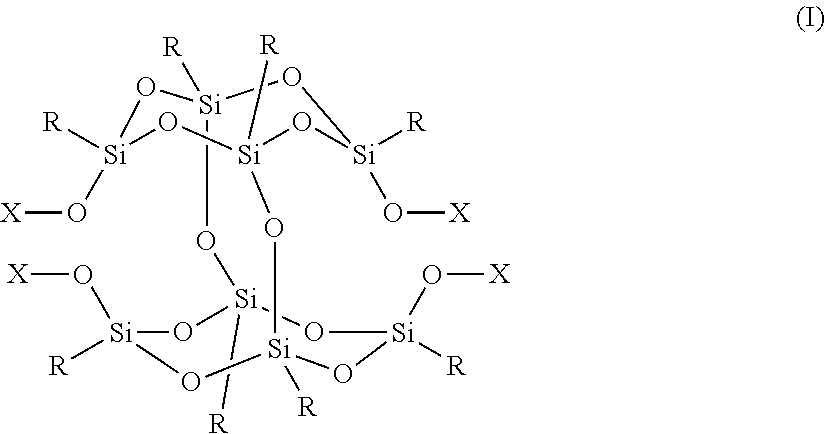Positive Photosensitive Composition
- Summary
- Abstract
- Description
- Claims
- Application Information
AI Technical Summary
Benefits of technology
Problems solved by technology
Method used
Image
Examples
synthesis example 1
Synthesis of Copolymer (B1)
[0093]A copolymer (B1) corresponding to the siloxane polymer (B) was synthesized in the following manner.
[0094]Loaded into a four-necked flask equipped with a stirrer were diethylene glycol ethyl methyl ether as a polymerization solvent, and tetraethoxysilane, dimethyldiethoxysilane, and phenyltriethoxysilane as monomers in the following weights, and a mixed solution of 10.3 g of formic acid and 16.0 g of water was added by dripping. After that, the mixture was heated at 80° C. for 1 hour, then subjected to distillation for 1 hour to remove low-molecular-weight components, and further subjected to distillation at 130° C. for 2 hours, to yield a polymer solution. The total amount of low-boiling-point components removed by the distillation was 76.3 g.
Diethylene glycol ethyl methyl ether100.0 gTetraethyl orthosilicate 34.8 gDiethoxydimethylsilane 12.3 gPhenyltriethoxysilane 40.0 g
[0095]The polymer solution was cooled to room temperature to yield a copolymer (...
synthesis example 2
Synthesis of Copolymer (B2)
[0096]The following components were loaded in the following weights in the same manner as that in Synthesis Example 1 except that a mixed solution of 10.3 g of formic acid and 14.6 g of water was dripped, to thereby perform polymerization. The same treatment as that in Synthesis Example 1 was conducted to yield a polymer solution. The total amount of low-boiling-point components removed by the distillation was 72.3 g.
Diethylene glycol ethyl methy ether100.0 gTetraethyl orthosilicate 34.8 gEthoxytrimethylsilane 6.0 gPhenyltriethoxysilane 40.0 g
[0097]Further, the polymer solution was cooled to room temperature to yield a copolymer (B2) solution. The resultant copolymer (B2) solution was subjected to GPC analysis (polystyrene standard). As a result, the weight average molecular weight was determined to be 4,200.
synthesis example 3
Synthesis of Copolymer (B3)
[0098]The following components were loaded in the following weights in the same manner as that in Synthesis Example 1 except that a mixed solution of 9.6 g of formic acid and 15.0 g of water was dripped, to thereby perform polymerization. The same treatment as that in Synthesis Example 1 was conducted to yield a polymer solution. The total amount of low-boiling-point components removed by the distillation was 72.4 g.
Diethylene glycol ethyl methyl ether100.0 gTetraethyl orthosilicate 34.8 gDiethoxydimethylsilane 6.2 gPhenyltriethoxysilane 40.0 g
[0099]Further, the polymer solution was cooled to room temperature to yield a copolymer (B3) solution. The resultant copolymer (B3) solution was subjected to GPC analysis (polystyrene standard). As a result, the weight average molecular weight was determined to be 4,200.
PUM
| Property | Measurement | Unit |
|---|---|---|
| Percent by mass | aaaaa | aaaaa |
| Percent by mass | aaaaa | aaaaa |
| Mass | aaaaa | aaaaa |
Abstract
Description
Claims
Application Information
 Login to View More
Login to View More - Generate Ideas
- Intellectual Property
- Life Sciences
- Materials
- Tech Scout
- Unparalleled Data Quality
- Higher Quality Content
- 60% Fewer Hallucinations
Browse by: Latest US Patents, China's latest patents, Technical Efficacy Thesaurus, Application Domain, Technology Topic, Popular Technical Reports.
© 2025 PatSnap. All rights reserved.Legal|Privacy policy|Modern Slavery Act Transparency Statement|Sitemap|About US| Contact US: help@patsnap.com



